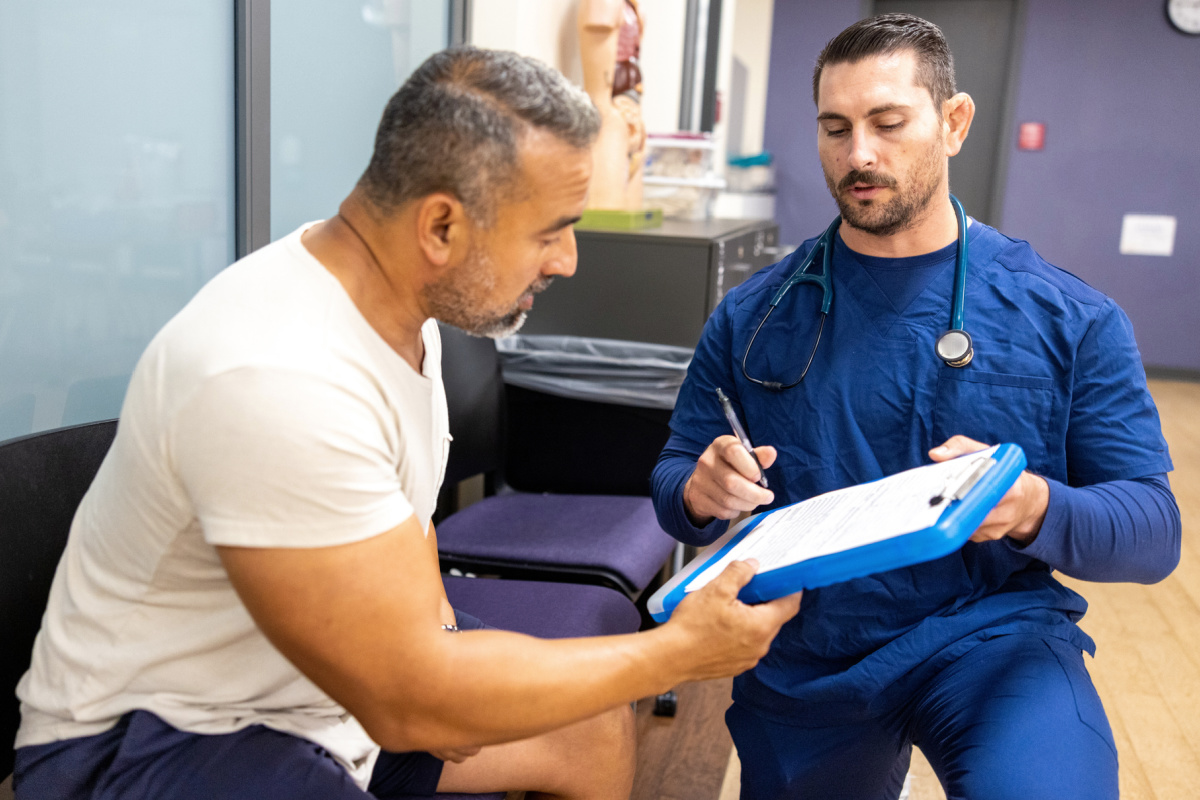
“What do you hope to get from this visit?”
This was the introductory question a physician asked me when I first met him.
I prioritized my goals and started a brief narrative. And away we went to the races.
The more I thought about this simple question, the more brilliant I thought it.
First, it sets a tone that my priorities are important, and a successful visit will be my determination, not the doctor’s. So, find out what matters the most to me.
Next, the question’s subtext is there is not enough time today to deal with every potential problem under the sun. So, let’s deal with the most important ones. Let’s not do a blind man’s walk into uncharted territory.
I contrast this history-gathering to an interview a medical student did just prior to the attending entering. The student was trying to stick to a mental script to make sure no details were missed. It was entry level chess compared to the attending’s grandmaster status. The medical student will acquire these skills over time. But, it takes time. There’s no easy way to learn this path. Still, I think this question, “What do you hope to get from this visit?” is also a great teaching tool.
Making a good diagnosis is the foundation of successful treatment.
Dr. Gurpeet Dhaliwal, a professor of medicine at UCSF, teaches medical students about the problem-solving process used in the NPR radio show, Car Talk. He applies the wisdom of Click and Clack, the Tappet Brothers, to medical students teaching them to diagnose disease.
“I would listen to their podcast every weekend,” Dhaliwal explains. “One day I said to myself, ‘My goodness, these guys are doing the same job I have.’ They collect the data, define the problem, and pick from several solutions. That’s essentially what a doctor does.”
First off, the caller describes his or her car troubles. Dhaliwal will ask students, “what is the core problem they’re trying to solve?” Dhaliwal explains.
In one Car Talk “case,” the problem was a 1994 Chevy Lumina making a chugging sound going uphill.
Then, Ray and Tom take a history.
“It’s an old car with 150,000 miles on it,” Dhaliwal explains. “The major problem when you’re chugging up the hill is you’re not getting enough fuel at a very peak demand.”
Lastly, the brothers present a potential fix.
“They realize there’s only two plausible solutions,” Dhaliwal says. “Either there’s a dirty fuel filter or there’s some bad spark plugs.”
That step-by-step process, Dhaliwal says, is exactly what his students need to do in the clinic.
Identify the make and model, i.e., the core problem. Take a history. Consider plausible hypotheses for the solution.
Dhaliwal explains how it might work with a human subject.
“This looks like a healthy 25-year-old man with a cough,” he says. “They have to trigger possible solutions for that. Could it be pneumonia? Could it be a simple virus? Could it be something as serious as tuberculosis? And as they get more data, they ultimately have to make a call and say which one of those things is most likely.”
It’s not just Ray and Tom’s reasoning skills that Dhaliwal admires. One other thing he teaches budding physicians to emulate is their ability to build rapport, with cheerfulness, kindness, and humility.
And Click and Clack had to make the diagnosis in minutes. Just like a doctor. And they had to keep the audience engaged – or the show never would have survived.
Of course, doctors don’t need to emulate all details of Click and Clack’s diagnostic process.
Dr. Gregory Brisson wrote an essay in Family Medicine:
“They would say things like, ‘If you get in that car and drive it before you get the wheel bearings checked, you’re gonna die! You don’t want to say things like that when you’re meeting with your patients.”
Most physicians do not remember their first history and physicals. If we had videotapes of them, we’d cringe. Perhaps we blocked them out. “What do you hope to get from this visit?” may make that painful educational process less onerous.
At Medical Justice, we follow a similar protocol. When a member contacts us, we diagnose the problem and provide solutions. And we remain involved until the member arrives at his or her outcome. Our job is to do everything possible to see it is a favorable one. If you’re staring down a medico-legal threat (or want to bullet-proof yourself against future threats), contact us. The resources below make it easy. All inquiries are confidential.
Perfect Patient Dismissal & Termination Letters
Respond Masterfully to Negative Patient Reviews
Discover the Regulatory Landmines Most Doctors Miss
Jeffrey Segal, MD, JD
Chief Executive Officer and Founder
Dr. Segal was a practicing neurosurgeon for approximately ten years, during which time he also played an active role as a participant on various state-sanctioned medical review panels designed to decrease the incidence of meritless medical malpractice cases.
Dr. Segal holds a M.D. from Baylor College of Medicine, where he also completed a neurosurgical residency. Dr. Segal served as a Spinal Surgery Fellow at The University of South Florida Medical School. He is a member of Phi Beta Kappa as well as the AOA Medical Honor Society. Dr. Segal received his B.A. from the University of Texas and graduated with a J.D. from Concord Law School with highest honors.
Dr. Jeffrey Segal, Chief Executive Officer and Founder of Medical Justice, is a board-certified neurosurgeon. In the process of conceiving, funding, developing, and growing Medical Justice, Dr. Segal has established himself as one of the country’s leading authorities on medical malpractice issues, counterclaims, and internet-based assaults on reputation.
Dr. Segal received his M.D. from Baylor College of Medicine, where he also completed a neurosurgical residency. Dr. Segal served as a Spinal Surgery Fellow at The University of South Florida Medical School. He is a member of Phi Beta Kappa as well as the AOA Medical Honor Society. Dr. Segal received his B.A. from the University of Texas and graduated with a J.D. from Concord Law School with highest honors.
Dr. Segal is also a partner at Byrd Adatto, a national business and health care law firm. With decades of combined experience in serving doctors, dentists, and other providers, Byrd Adatto has a national pedigree to address most legal issues that arise in the business and practice of medicine.





The specific car repair analogy is terrible for this reason:
I had similar issues with a car in the 1970’s, and yes it was a fuel filter.
In the 1980’s someone described the same scenario I experienced and the same was what was described in the answer. However, before I could complete my diagnosis of a fuel filter that was bad, I was told that the car (a mid 1980s Toyota) was actually experiencing a circuit board issue that was an electronic problem. The symptoms were the same, but the fix was completely different.
My point is that one should not be lead astray by poor car repair examples. In medicine there are a number of different conditions that have similar symptoms. One needs to take a thorough history and then do a physical exam, and then do appropriate diagnostic testing before one can come to an actual diagnosis.
A recent code alert on my son’s vehicle was diagnosed as something that required hundreds of dollars of parts replacements related to the fuel system, as diagnosed by the local chain auto parts store. When I had him take the car to the dealership they got a similar code, but their mechanics with experience taking care of those cars, diagnosed the problem as an air filter housing issue. The repair cost less than $50, and the problem and warning lights have not recurred. The moral here is that it takes an experienced practitioner to take a detailed history and not to immediately decide with a few questions what the diagnosis is.
No doctor gets it right 100% of the time. Car Talk did not get it right 100% of the time. Still, each party uses heuristics to get it right more often than other search strategies when constrained by time. Of course, a thorough history and exam needs to be done. If a practice is seeing 45 people in one day, not every patient will get that thorough history. There just is not enough time.
Regarding the referenced automobile recall, that’s another diagnostic clue. If there’s an influenza epidemic across the region, for example, and your patient has symptoms of influenza, that’s likely where the money is. If there’s no external information of such an epidemic, odds are lower it’s the flu.
No practice should just perform histories in the way Click and Clack did. But, there’s some wisdom in their techniques in moving the process along and sifting through limited information to make an educated hypothesis.
Car Talk, ❤️ Jeff Segal
I think it’s an excellent introductory question, the answer to which of course is not, in and of itself going to lead to a complicated diagnosis. But it sets the stage by letting the patient know that it’s THEIR agenda, that they will not be ignored in favor of an EHR or an ulterior motive/agenda, and THEN (gently) that they need to prioritize.
Another superb question that can help cut to the chase but comes along a little later in the interview is “…and what is it about that (symptom, complaint) that worries you?” It’s a little bit harder to ask, because of course it can come across as pejorative if the exact right tone is not used. But in so many cases, this question will reveal the ACTUAL (not the putative) reason for the visit; and can then sometimes allow the physician to immediately dispel any concern that is not well based in medical science (but rather often comes from Dr. Google, a family member’s experience, a neighbor’s dire warning….) . I love both of these questions.
The third most important question that I ask (if it is not already obvious from questions #1 and #2) is “…and how (do you feel that I) can I help you accomplish (that)?” Because it again tells the patient who is in charge of their care (they are) and focuses narrowly on how we, with our skills/rights/privileges can assist them in THEIR quest for health, that THEY will then direct and operationalize, hopefully with the benefit of our specialized knowledge and assistance.
This approach is a little more open ended than the “Click and Clack” approach, but then I don’t need to engage a radio audience. Just my patient.